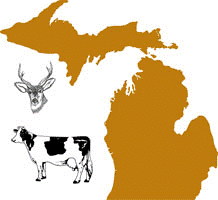Wildlife Disease and Zoonotics
Date of this Version
2004
Abstract
Bovine tuberculosis (BTB) was introduced into Swedish farmed deer herds in 1987. Epidemiological investigations showed that 10 deer herds had become infected (July 1994) and a common source of infection, a consignment of 168 imported farmed fallow deer, was identified (I).
As trace-back of all imported and in-contact deer was not possible, a control program, based on tuberculin testing, was implemented in July 1994. As Sweden has been free from BTB since 1958, few practicing veterinarians had experience in tuberculin testing. In this test, result relies on the skill, experience and conscientiousness of the testing veterinarian. Deficiencies in performing the test may adversely affect the test results and thereby compromise a control program.
Quality indicators may identify possible deficiencies in testing procedures. For that purpose, reference values for measured skin fold thickness (prior to injection of the tuberculin) were established (II) suggested to be used mainly by less experienced veterinarians to identify unexpected measurements. Furthermore, the within-veterinarian variation of the measured skin fold thickness was estimated by fitting general linear models to data (skin fold measurements) (III). The mean square error was used as an estimator of the within-veterinarian variation. Using this method, four (6%) veterinarians were considered to have unexpectedly large variation in measurements.
In certain large extensive deer farms, where mustering of all animals was difficult, meat inspection was suggested as an alternative to tuberculin testing. The efficiency of such a control was estimated in paper IV and V. A Reed Frost model was fitted to data from seven BTB-infected deer herds and the spread of infection was estimated (< 0.6 effective contacts per deer and year) (IV). These results were used to model the efficiency of meat inspection in an average extensive Swedish deer herd. Given a 20% annual slaughter and meat inspection, the model predicted that BTB would be either detected or eliminated in most herds (90%) 15 years after introduction of one infected deer. In 2003, an alternative control for BTB in extensive Swedish deer herds, based on the results of paper V, was implemented.



Comments
Acta Universitatis Agriculturae Sueciae
Veterinaria 178